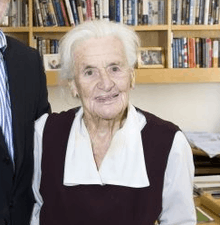Ines Mandl
Ines Mandl (April 4, 1917 – August 5, 2016) was an Austrian-born American biochemist who was awarded the Garvan-Olin Medal in 1983 for her work on the enzyme collagenase.[1][2] She was a professor at Columbia University.[3]
Ines Mandl | |
|---|---|
 fair use image only | |
| Born | 1917 Vienna |
| Died | 2016 |
| Alma mater |
|
| Awards | Garvan-Olin Medal |
| Scientific career | |
| Fields | biochemistry |
| Institutions | Columbia University |
Early life and education
Ines Hochmuth was born in 1917, in Vienna, the only child of Ernst and Ida (née Bassan) Hochmuth. She completed elementary and secondary school in Austria, then married one of her father's colleagues, Hans Mandl, and moved to London. In Ireland during World War II, she earned a diploma in chemical technology from University College Cork.[4]
After the war, she pursued graduate education in chemistry in the United States, earning a master's degree in 1947 and completing doctoral studies in 1949, at the Polytechnic Institute in Brooklyn (now New York University Tandon School of Engineering).[5]
She was one of the last students of Carl Neuberg, the "Father of Biochemistry."[6]
Career
Ines Mandl accepted a job in the surgery department at Columbia University after finishing her PhD in 1949, and stayed at Columbia for the rest of her career. In 1950, she became the first scientist to extract collagenase from the bacterium Clostridium histolyticum.[7] Other work involved the study of respiratory distress in newborns, and the biochemistry of pulmonary emphysema. She held a teaching appointment in microbiology, and co-authored more than 140 academic publications.[8]
In 1972, Mandl founded an academic journal in her field, Connective Tissue Research; she was editor of the journal from its first issue until her retirement in 1986.[9]
Her work was recognized in 1977 with the Carl Neuberg Medal from the American Society of European Chemists and Pharmacists, and in 1983 with the Garvan Medal from the American Chemical Society. She was also awarded the Austrian Cross of Honour for Science and Art, was elected to the American Academy of Arts and Sciences, and the New York Academy of Sciences.[10]
Legacy
Ines Mandl made a substantial endowment to her alma mater, New York University Tandon School of Engineering, for undergraduate scholarships and graduate fellowships in chemical engineering and biological sciences.[8] In recent decades, collagenase has begun to find various practical medical applications.[7]
The Ines Mandl Medical Foundation of Budapest held an award competition in celebration of Mandl's 90th birthday in 2007.[11]
External links
- Interview with Ines Mandl at the Leo Baeck Institute Archives.
References
- Ines Mandl, Collagenase (Gordon and Breach 1972).
- "Ines Mandl". Legacy. Retrieved 11 August 2016.
- "Pioneering Biochemist's NYU-Poly Fellowships Support Future Scientists | Cable". Engineering.nyu.edu. Retrieved 2016-09-25.
- Gisela M. B. Holfter, German-speaking Exiles in Ireland, 1933-1945 (Rodopi 2006): 83-84; ISBN 9789042020337
- Ines Mandl oral history interview, Leo Baeck Institute, Austrian Heritage Collection (2014).
- D. Nachmansohn, German-Jewish Pioneers in Science, 1900-1933 (Spring Science and Business Media 2012): 323. ISBN 9781461299707
- Andrew Pollack, "Triumph for a Drug to Straighten Clenched Fingers" New York Times (March 15, 2010).
- "Pioneering Biochemist's NYU-Poly Fellowships Support Future Scientists" Cable Alumni Magazine (Winter 2012).
- J. Peter Bentley, "Review of Connective Tissue Research. An International Journal, Ines Mandl," The Quarterly Review of Biology 48(1)(March 1973): 60-61. doi: 10.1086/407583
- Elizabeth H. Oakes, Encyclopedia of World Scientists (Infobase Publishing 2007): 479-480. ISBN 9781438118826
- Anna Kádár and J. Mathias Baló-Banga, "An Award Competition in Honor of Dr. Mandl's Ninetieth Birthday" Connective Tissue Research 48(2)(2007): 124.
Further reading
- Shearer, Benjamin F.; Shearer, Barbara Smith (1997). Notable women in the physical sciences : a biographical dictionary. Westport, Conn.: Greenwood Press. ISBN 9780313293030.